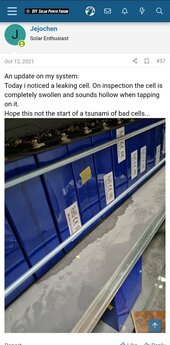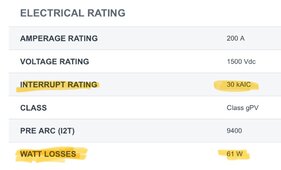This really sickens me to hear about the OP’s loss. I’m glad no one was physically harmed.
I’d be a bit pessimistic about the actual cause, because the fire could definitely obliterate it. The fuse, though not my favorite shouldn’t have caused the problem. The fact that it happened at a low demand period makes this more confusing. My only takeaways are perhaps an insulation failure of a battery case to another cell or metal structure in the vicinity? I hadn’t seen any visible cell isolation. A loosened terminal somewhere in the system that spat arcs & sparks? I’ve noticed that terminals do loosen over time but mostly early on, so it’s always a good idea to check all torques of every connection. As mentioned before, a good smoke detector could have perhaps given early warning and if home at the time to intervene before the damage was so extensive. A smoke detector with combination photo & ionic detectors wired into the house system would be advantageous. Mine is so sensitive that I can’t do a few moments of heat shrinking near it. Again this is rough., sorry.
I’d be a bit pessimistic about the actual cause, because the fire could definitely obliterate it. The fuse, though not my favorite shouldn’t have caused the problem. The fact that it happened at a low demand period makes this more confusing. My only takeaways are perhaps an insulation failure of a battery case to another cell or metal structure in the vicinity? I hadn’t seen any visible cell isolation. A loosened terminal somewhere in the system that spat arcs & sparks? I’ve noticed that terminals do loosen over time but mostly early on, so it’s always a good idea to check all torques of every connection. As mentioned before, a good smoke detector could have perhaps given early warning and if home at the time to intervene before the damage was so extensive. A smoke detector with combination photo & ionic detectors wired into the house system would be advantageous. Mine is so sensitive that I can’t do a few moments of heat shrinking near it. Again this is rough., sorry.





